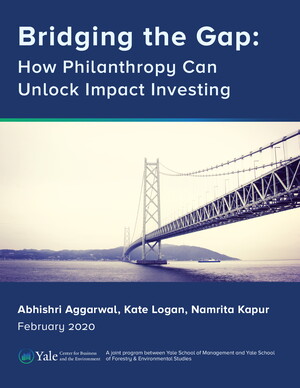Bridging the Gap: How Philanthropy Can Unlock Impact Investing

-by Abhishri Aggarwal, Kate Logan, Namrita Kapur
Overview
Impact investing holds great potential where philanthropy falls short—mobilizing the scale of financial resources needed to address the world’s pressing problems. According to the Global Impact Investing Network (GIIN) total global impact investing assets in 2018 grew more than 50% from 2017. Yet, that growth is tiny relative to the overall investing marketplace—comprising only 4% of total socially responsible assets under management in the US, and only 1% of total US assets under management.1
Furthermore, there is evidence to suggest that assets committed for impact investment are largely sitting on the sidelines. For example, NatureVest’s 2016 report—“The State of Private Investment in Conservation” —found that of the $8.2 billion committed to conservation, $3.1 billion was undeployed.2 This is a real frustration considering what we know about the enormous need and urgency for those resources.
Building upon preliminary research presented by Namrita Kapur of Growald Family Fund during a September 2019 talk at Yale School of Management,3 this report explores specific mechanisms and case studies to articulate and elevate potential roles for philanthropy to activate impact investing.
Drawing from interviews with key stakeholders and a literature review, the report outlines three primary avenues—financial tools, addressing structural gaps, and capacity building—through which philanthropy can serve to mitigate or resolve market failures that inhibit deployment of impact investing capital. In-depth cases on Root Capital and Encourage Capital illustrate how these strategies function in practice. It concludes with a series of recommendations for how efforts to leverage philanthropy to unlock impact investing could be scaled up: 1) actively foster communication; 2) broaden approach of endowments; 3) leverage philanthropy as risk capital; and 4) target resources for catalytic potential.
This report will be most helpful to organizations that seek to strategically deploy grant money that will create leverage in their impact investing portfolio. In fact, we believe a side benefit to this report may be facilitating stronger communication between grantmakers and impact investors. It may also be of immediate relevance for conferences and networks that intend to unite both sides of the spectrum. The report’s recommendations hold catalytic potential, but they will require communication and intentionality on behalf of these groups in order to rewrite the current status quo.
